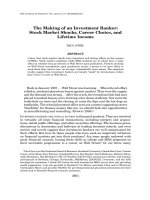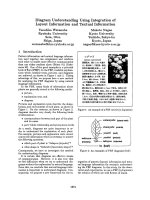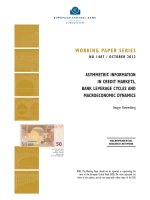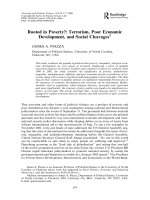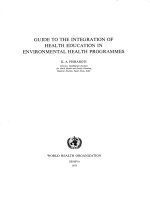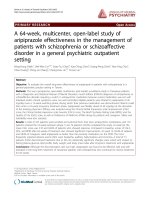Integration of Weather Information in Transportation Management Center Operations: Self-Evaluation and Planning Guide doc
Bạn đang xem bản rút gọn của tài liệu. Xem và tải ngay bản đầy đủ của tài liệu tại đây (592.72 KB, 111 trang )
Integration of Weather
Information in Transportation
Management Center Operations:
Self-Evaluation and Planning
Guide
June 30, 2008
Notice
The U.S. Department of Transportation provides high-quality information to serve
Government, industry, and the public in a manner that promotes public
understanding. Standards and policies are used to ensure and maximize the
quality, objectivity, utility, and integrity of its information. USDOT periodically
reviews quality issues and adjusts its programs and processes to ensure
continuous quality improvement.
iii
Technical Report Documentation
1. Report No.
FHWA-JPO-08-057
2. Government Accession No.
3. Recipient’s Catalog No.
EDL# 14437
4. Title and Subtitle
Integration of Weather Information in Transportation Management Center Operations:
Self-Evaluation and Planning Guide
5. Report Date
June 30, 2008
6. Performing Organization Code
7. Author(s)
Chris Cluett and Deepak Gopalakrishna (Battelle), Kevin Balke (Texas Transportation
Institute), Fred Kitchener (McFarland Management, LLC), Leon Osborne (Meridian
Environmental Technology, Inc.)
8. Performing Organization Report
9. Performing Organization Name and Address
Battelle Seattle Research Center
1100 Dexter Avenue North, Suite 400
Seattle, WA 98109-3598
10. Work Unit No. (TRAIS)
11. Contract or Grant No.
DTFH61-06-D-00007; Task BA07-012
12. Sponsoring Agency Name and Address
United States Department of Transportation
Federal Highway Administration, Office of Operations
1200 New Jersey Ave., SE
Washington, DC 20590
13. Type of Report and Period Covered
Evaluation Report, 7/18/06 –6/30/08
14. Sponsoring Agency Code
HOIT
15. Supplementary Notes
Mr. Roemer Alfelor (COTM)
16. Abstract
The Federal Highway Administration’s Road Weather Management Program is helping to reduce the adverse impacts of weather on the
transportation system by assisting agencies in integrating weather information and technologies into their daily Transportation
Management Center (TMC) operations. In order to achieve this goal the TMCs have to evaluate their needs for weather integration and
develop a plan to implement strategies that meet those needs. This report presents a self-evaluation guide that helps a TMC identify the
relevant weather events in their jurisdiction, determine the type and magnitude of impacts those events have on their transportation
system and on TMC operations and traffic management responsibilities, identify current strategies for managing the impacts of weather,
prioritize their identified needs for weather information application and integration, and identify integration strategies and solutions that
are best suited to meeting the TMC’s high priority needs. The results of the self-evaluation serve as input to support the preparation of a
weather information integration plan for TMCs. This report is a companion document to the electronic database version of the guide.
17. Key Words
Road Weather Management, Integration, Transportation
Management Center (TMC), Self-Evaluation Guide, Weather
Integration Planning
18. Distribution Statement
No restrictions. This document is available to the public.
19. Security Classif. (of this report)
Unclassified
20. Security Classif. (of this page)
Unclassified
21. No. of Pages
90
22. Price
N/A
Form DOT F 1700.7 Reproduction of completed page authorized.
iii
Table of Contents
INTRODUCTION 1
Organization of the Guide 1
Completing the Self-Evaluation and Planning Process 4
Step 1: Preparing for the Self-Evaluation 4
Step 2: Conducting the Self-Evaluation 4
Step 3: Assessing and selecting weather integration strategies 4
Step 4: Preparing the Weather Integration Plan 5
PART I. SELF-EVALUATION 7
Section 1: Weather Conditions 9
Section 2: Weather Impacts on TMC Operations 12
Section 3: Current Weather Management and Integration Framework 15
Section 4: TMC Operational Needs Assessment 27
PART II. PLANNING AND GUIDANCE 31
Section 5: Suggested Weather Integration Strategies 33
Section 6: List of Weather Integration Strategies 47
6.1 Item of Integration – Use of Internal Weather Information Resources
49
6.1.1 Strategies (or Levels of Integration) 49
6.1.2 Level of Complexity and Relative Costs 50
6.1.3 Requirements at Various Levels of Integration 51
6.2 Item of Integration – Use of External Weather Information Resources
54
6.2.1 Strategies (or Levels of Integration) 54
6.2.2 Level of Complexity and Relative Costs 55
6.2.3 Requirements at Various Levels of Integration 56
6.3 Item of Integration – Availability of Weather Information 57
6.3.1 Strategies (or Levels of Integration) 57
6.3.2 Level of Complexity and Relative Costs 58
6.3.3 Requirements at Various Levels of Integration 59
6.4 Item of Integration – Frequency of Weather Forecasts 60
6.4.1 Strategies (or Levels of Integration) 60
6.4.2 Level of Complexity and Relative Costs 61
6.4.3 Requirements at Various Levels of Integration 61
6.5 Item of Integration – Frequency of Road Weather Observations 63
6.5.1 Strategies (or Levels of Integration) 63
iv
6.5.2 Levels of Complexity and Relative Costs 64
6.5.3 Requirements at Various Levels of Integration 65
6.6 Item of Integration – Weather Information Coordination 67
6.6.1 Strategies (or Levels of Integration) 67
6.6.2 Levels of Complexity and Relative Costs 68
6.6.3 Requirements at Various Levels of Integration 68
6.7 Item of Integration – Extent of Coverage 71
6.7.1 Strategies (or Levels of Integration) 71
6.7.2 Levels of Complexity and Relative Costs 72
6.7.3 Requirements at Various Levels of Integration 73
6.8 Item of Integration – Interaction with Meteorologists 77
6.8.1 Strategies (or Levels of Integration) 77
6.8.2 Level of Complexity and Relative Costs 78
6.8.3 Requirements at Various Levels of Integration 79
6.9 Item of Integration - Alert Notification 81
6.9.1 Strategies (or Levels of Integration) 81
6.9.2 Level of Complexity and Relative Costs 83
6.9.3 Requirements at Various Levels of Integration 83
6.10 Item of Integration - Decision Support 85
6.10.1 Strategies (or Levels of Integration) 85
6.10.2 Level of Complexity and Relative Costs 86
6.10.3 Requirements at Various Levels of Integration 87
6.11 Item of Integration-Weather/Road Weather Data Acquisition 90
6.11.1 Strategies (or Levels of Integration) 90
6.11.2 Level of Complexity and Relative Costs 91
6.11.3 Requirements at Various Levels of Integration 91
PART III. TMC WEATHER INTEGRATION PLANNING 96
Section 7. Developing a Weather Integration Plan 98
APPENDIX A. DESCRIPTIONS OF WEATHER EVENTS 102
v
List of Tables
Table 3.1. Items of Integration 17
Table 5.1 Needs vs. Item(s) of Integration Matrix 35
Table 5.2 Sample Application of the Matrix Using Results of Section 3 (Current
Status
is in Bold, Italic, Yellow Highlight) 38
Table 5.2 Sample Application of the Matrix Using Results of Section 3 (Current
Status
is in Bold, Italic, Yellow Highlight) (continued) 40
Table 5.3 Identify Critical Need in the Needs vs. Integration Item matrix (from
Table 5.1)* 40
Table 5.4 Current Status is in Bold, Italic, Yellow Highlight - Level Required to
Address Critical Need in Bold Box, Pink Highlight (from Table 5.3) 42
Table 5.5 Suggested Strategies for Critical Need 45
Table 6.1 Items of Integration 49
Table 6.2 Relative Complexity and Cost of Implementing Different Levels for
the Item of Integration – Use of Internal Weather Information Resources
51
Table 6.3 Requirements Across Five Integration Dimensions and Levels for the
Item of Integration – Use of Internal Weather Information Resources *51
Table 6.4 Relative Complexity and Cost of Implementing Different Levels for
the Item of Integration - External Weather Information Resources 55
Table 6.5 Requirements Across Five Integration Dimensions and Levels for the
Item of Integration - External Weather Information Resources * 56
Table 6.6 Relative Complexity and Cost of Implementing Different Levels for
the Item of Integration - Availability of Weather Information 58
Table 6.7 Requirements Across Five Integration Dimensions and Levels for the
Item of Integration - Availability of Weather Information * 59
Table 6.8 Relative Complexity and Cost of Implementing Different Levels for
the Item of Integration - Frequency of Weather Forecasts 61
Table 6.9 Requirements Across Five Integration Dimensions and Levels for the
Item of Integration - Frequency of Weather Forecasts * 61
Table 6.10 Relative Complexity and Cost of Implementing Different Levels for
the Item of Integration - Frequency of Road Weather Observations 64
Table 6.11 Requirements Across Five Integration Dimensions and Levels for
the Item of Integration - Frequency of Road Weather Observations * 65
vi
Table 6.12 Relative Complexity and Cost of Implementing Different Levels for
the Item of Integration - Weather Information Coordination 68
Table 6.13 Requirements Across Five Integration Dimensions and Levels for
the Item of Integration - Weather Information Coordination * 69
Table 6.14 Relative Complexity and Cost of Implementing Different Levels for
the Item of Integration - Extent of Coverage 73
Table 6.15 Requirements Across Five Integration Dimensions and Levels for
the Item of Integration - Extent of Coverage * 73
Table 6.16 Relative Complexity and Cost of Implementing Different Levels for
the Item of Integration - Interaction with Meteorologists 78
Table 6.17 Requirements Across Five Integration Dimensions and Levels for
the Item of Integration - Interaction with Meteorologists * 79
Table 6.18 Relative Complexity and Cost of Implementing Different Levels for
the Item of Integration - Alert Notification 83
Table 6.19 Requirements Across Five Integration Dimensions and Levels for
the Item of Integration - Alert Notification * 83
Table 6.20 Relative Complexity and Cost of Implementing Different Levels for
the Item of Integration - Decision Support 87
Table 6.21 Requirements Across Five Integration Dimensions and Levels for
the Item of Integration - Decision Support * 87
Table 6.22 Relative Complexity and Cost of Implementing Different Levels for
the Item of Integration - Weather/Road Weather Data Acquisition 91
Table 6.23 Requirements Across Five Integration Dimensions and Levels for
the Item of Integration - Weather/Road Weather Data Acquisition * . 91
List of Figures
Figure 1 – Self-Evaluation and Planning Guide Organization 3
Integration of Weather Information in Transportation Management Center Operations
Self-Evaluation and Planning Guide
1 Introduction
INTRODUCTION
The Federal Highway Administration’s Road Weather Management Program is helping to
reduce the adverse impacts of weather on the transportation system by assisting agencies in
integrating weather information and technologies in their daily Transportation Management
Center (TMC) operations. In order to achieve this goal the TMCs have to evaluate their needs for
weather integration and develop a plan to implement strategies that meet those needs.
The potential benefits of weather information integration in TMC operations can be substantial.
These include a more proactive approach to operations and maintenance that will lead to safer
travel, better information for both highway operators and travelers, reduced operating costs,
more efficient and cost-effective use of resources (labor, materials, equipment), better
coordination among agencies, and more effective operational decision making.
This self-evaluation and planning guide will lead you (TMCs) through the following steps:
• Identify the relevant weather events in your jurisdiction.
• Determine the type and magnitude of impacts these events have on your transportation
system, and hence on TMC operations and traffic management responsibilities.
• Identify your current strategies for managing the impacts of weather on your operations.
• Prioritize your needs for weather information application and integration.
• Identify integration strategies and solutions that are best suited to meeting your high
priority needs.
The results of this self-evaluation will serve as input to guide the preparation of your weather
integration plan. The strategies for integration of weather information appropriate to address
TMC needs are not intended to imply FHWA standards or requirements; rather, the guide offers
solution strategies as options to consider as you plan for future weather integration. The weather
integration plan will provide the TMC a clear roadmap for incorporating weather information in
various operational activities and decision-making.
Moreover, the self-evaluation is not intended to rate your current program or compare it with
other programs but rather to enable identification of potential methods for integrating weather
information into your TMC operations. The evaluation should not be used to compare programs
and does not report scores or ratings in any way.
Organization of the Guide
The process to conduct the TMC self-evaluation and develop a plan for weather integration is
presented as three major parts in the Guide as follows:
Part I. Self Evaluation
Part II. Guidance for Weather Integration
Part III. Development of a Weather Integration Plan
Integration of Weather Information in Transportation Management Center Operations
Self-Evaluation and Planning Guide
2 Introduction
The steps or components of each part are illustrated in Figure 1.
Parts I and II are considered the Self-Evaluation and Planning processes, while Part III provides
information and guidance on developing the integration plan.
Part I of the Guide consists of four sections with checklists/questions within each. The four
sections of the evaluation are:
• Section 1 – Weather conditions: This section identifies the major weather conditions in
the region.
• Section 2 – Weather impacts on operations: For the weather conditions identified in
Section 1, this section determines their impacts on traffic and TMC
operations.
• Section 3 – Current management and integration framework: This section defines the
current weather information management framework including identifying
existing strategies and processes.
• Section 4 – TMC operational needs for weather integration.
Part II of the Guide consists of two sections:
• Section 5 – This section links the weather integration strategies with high priority
operational needs and provides a process for identifying appropriate
strategies for the region.
• Section 6 – This section provides several reports including further explanation and detail
on weather information integration strategies.
Part III of the Guide provides guidance on developing a typical weather integration plan. A
sample outline for an integration plan is included.
3
Introduction
Integration of Weather Information in Transportation Management Center Operations
Self-Evaluation and Planning Guide
II. Guidance for Weather Integration
I. Self-Evaluation
Section 1 – Weather
Conditions
(Type, Frequency,
Intensity, Duration)
Section 2 – Weather
Impacts on Operations
(Impacts on Traffic,
Impacts on Job Function
and TMC activity)
Section 4 – TMC
Operational Needs
Assessment
Result – List of Weather
Events of Interest to the
region
Result – Impacts of
Weather Events on TMC
Operations
Result- Prioritized List of
weather-related
operational needs
Section 5 – Suggested Weather Integration
Strategies
Op. Need 1 Op Need 2 Op. Need 3
Wx Int Stgy #1 X
Wx Int Stgy #2 X
Wx Int Stgy #3 X
Wx Int Stgy #4 X X
Wx Int Stgy #5 X
Wx Int Stgy #1
Wx Int Stgy #2
Wx Integration Stgy #1
Description/Definition
Possible Implementation
tasks and feasibility
assessment by integration
dimension
O Operational
O Physical
O Technical
O Procedural
O Institutional
Relative Implementation
complexity (High, Medium,
Low)
Relative cost factor (High,
Medium, Low)
Section 3 – Current
Weather Management
and Integration
Framework
Result – Identification of
current operational
weather management
infrastructure, strategies,
and integration
Section 6 – List of Weather
Integration Strategies
This section allows the TMC to identify the
weather events of interest , the impacts to
TMC operations and users , the existing
weather management framework , and the
TMC’s desired operational strategies with
respect to weather .
This section uses the information
collected in sections 1 to 4 and
suggests guidance on potentially
applicable weather information
integration strategies . Potential and
appropriate strategies , selected by the
TMCs, along with information from
sections 1-4 will then be used to
develop a Weather Integration Plan .
III. Weather Integration
Plan Development
LEGEND
TMC Inputs/Review
Results/Reports
The Integration
Plan is intended to
be a separate
follow-up activity
following the self-
evaluation and
guidance process .
Figure 1 – Self-Evaluation and Planning Guide Organization
Integration of Weather Information in Transportation Management Center Operations
Self-Evaluation and Planning Guide
4 Introduction
Completing the Self-Evaluation and Planning Process
An electronic version of the Guide was developed and will be distributed as a companion to this
document. It is recommended that the TMC utilize this database tool to conduct the self-
evaluation and use the manual Guide as reference throughout the process.
There are four steps that a TMC will follow to achieve a completed integration plan:
• Step 1: Preparing for the Self-Evaluation
• Step 2: Conducting the Self-Evaluation
• Step 3: Assessing and selecting weather integration strategies
• Step 4: Preparing the Integration Plan
Each step is described in greater detail below.
Step 1: Preparing for the Self-Evaluation
The following activities are recommended:
• Identify a lead TMC person to be the champion for this effort.
• Identify the self-evaluation team comprised of various stakeholders within and outside
the TMC. Before initiating the self-evaluation process, identify the individuals in your
TMC organization and other local agencies who are best positioned and experienced to
address the steps outlined above, and involve them throughout the process. The lead
person will assemble the appropriate evaluation team to participate in the activity. The
evaluation team may include staff responsible for:
o TMC center operations
o TMC field and roadside operations
o Public safety and emergency management
o Weather information
o Technology and systems integration
o Maintenance and construction operations
• Plan and schedule meetings.
Step 2: Conducting the Self-Evaluation
• Using the guide, the evaluation team will proceed through the steps to complete their
self-evaluation using the database tool.
• Identify a facilitator for the meetings and nominate staff to document the discussions
during the self-evaluation
Step 3: Assessing and selecting weather integration strategies
• The evaluation team will review the results of the self-evaluation and the guidance that
will include several candidate weather integration strategies that are suitable for meeting
the high priority weather integration needs of the TMC.
Integration of Weather Information in Transportation Management Center Operations
Self-Evaluation and Planning Guide
5 Introduction
The results from the self-evaluation will provide the input for preparing a Weather Integration
Plan.
Step 4: Preparing the Weather Integration Plan
• The TMC will develop the Weather Integration Plan in consultation with the self-
evaluation team and make any adjustments required to tailor the plan for their TMC.
Integration of Weather Information in Transportation Management Center Operations
Self-Evaluation and Planning Guide
7 Part I. Self-evaluation
PART I.
SELF-EVALUATION
Integration of Weather Information in Transportation Management Center Operations
Self-Evaluation and Planning Guide
9 Part I. Self-evaluation
Section 1: Weather Conditions
The objective of this first section is to identify what weather events occur most frequently and
impact traffic conditions in your region. There are many different types of weather events that
can occur across the country, but only some of these are likely to be of importance to your TMC
operations.
This section is not intended to collect detailed climatology information about your region.
Rather, the information collected will help narrow the focus to those weather events that impact
TMC operations. In the database-version, only the weather events selected in question 1-1
below will carry forward to the other questions in Section 1 as well as subsequent sections of the
Guide. In addition, this subset of weather events will be used to provide the appropriate local
context for your TMC as you develop the weather integration plan.
Self-Evaluation Questions
1.1 What types of weather events occur in your region and how frequently do
you experience them? If a weather event is not listed, please add it to the
end of the list (in the blank cells) and specify the frequency of the weather
event. Weather definitions are provided in Appendix A.
Note: Never The weather event does not occur in the region
Rare Once in two-three years
Seldom Once or twice a season
Occasional 3 to 5 times a season
Regular More than 10 times during a typical season
Weather Event Never Rare Seldom Occasion
al
Regular
Drizzle and Light Rain
Moderate to Heavy Rain
Sleet, and Freezing Rain
Thunderstorms with rain
Severe Thunderstorms
Flooding
Flurries and Light Snow
Moderate to Heavy Snow
Blizzard
Blowing Snow
High Winds
Blowing Sand or Dust
Smoke, Mist, Fog, Smog or
Haze
Bridge Frost, Road Frost
Tornadoes
Tropical Storms and
Hurricanes
Integration of Weather Information in Transportation Management Center Operations
Self-Evaluation and Planning Guide
10 Part I. Self-evaluation
Temperature Extremes
Others (please specify)
1.2 For the weather events that you identified above, to what geographic extent
would you classify their impacts on traffic operations in your region?
Weather Event
Local/Isolat
ed
Spots
Corridor-
Wide
Region/
Regional
State-
wide
Drizzle and Light Rain
Moderate to Heavy Rain
Sleet, and Freezing Rain
Thunderstorms with rain
Severe Thunderstorms
Flooding
Flurries and Light Snow
Moderate to Heavy Snow
Blizzard
Blowing Snow
High Winds
Blowing Sand or Dust
Smoke, Mist, Fog, Smog or
Haze
Bridge Frost, Road Frost
Tornadoes
Tropical Storms and
Hurricanes
Temperature Extremes
1.3 To what extent do the weather events usually impact the traffic flow on your
highway system? Impacts on traffic flow include increased travel times,
increased crash risk, low visibility and disruption of vehicle operations.
Weather Event
No
Impact
Little
Impact
Moderate
Impact
Significant
Impact
Drizzle and Light Rain
Moderate to Heavy Rain
Sleet, and Freezing Rain
Thunderstorms with rain
Severe Thunderstorms
Flooding
Flurries and Light Snow
Moderate to Heavy Snow
Blizzard
Blowing Snow
High Winds
Blowing Sand or Dust
Smoke, Mist, Fog, Smog or
Integration of Weather Information in Transportation Management Center Operations
Self-Evaluation and Planning Guide
11 Part I. Self-evaluation
Haze
Bridge Frost, Road Frost
Tornadoes
Tropical Storms and
Hurricanes
Temperature Extremes
Integration of Weather Information in Transportation Management Center Operations
Self-Evaluation and Planning Guide
12 Part I. Self-evaluation
Section 2: Weather Impacts on TMC Operations
Weather often impacts the activities of individuals and agencies working to maintain safety and
mobility of the transportation system. Making sense of weather information along with
recognizing the benefits of its application beyond the simplest case is not a trivial task. As a
generalization, TMC operators tend to take action based on their observations of traffic impacts
rather than responding directly to available weather information. It is important to understand the
nature of weather impacts on capacity and speed reductions, on safety (e.g., crash risk/frequency,
incident management including Safety Service Patrols that are often dispatched from or
coordinated with TMCs), and on institutional coordination (i.e., need for communication
between traffic managers and maintenance, emergency management, and law enforcement
personnel) to ensure that the self-evaluation and the integration solutions address the right
concerns. The ability to estimate impacts could presumably lead to managing freeway and
arterial systems more efficiently using advisory, control, and treatment strategies.
The previous section identified all the weather events of interest to the region and the TMC. This
section focuses on identifying the impacts of these weather events on your TMCs traffic
operations. Consider impacts on both the transportation system users and operators.
Self-Evaluation Questions
2.1 For the weather events that you identified above, which traffic impacts are
commonly associated with the weather events in your region? If the impact
is not listed, list the key traffic impact of concern in the space below.
Weather Event
Increas
ed
Travel
Times
Increase
d Crash
Risk
Reduce
d
Roadwa
y
Capacit
y
Traffic
Management
Device
Impairment
(signal outages,
lane control,
etc)
Disruption of
Commercial or
Other
Specialized
Vehicle
Operations
Road
Closures
Other
(Please
Specify)
Drizzle and Light Rain
Moderate to Heavy Rain
Sleet, and Freezing Rain
Thunderstorms with rain
Severe Thunderstorms
Flooding
Flurries and Light Snow
Moderate to Heavy Snow
Blizzard
Blowing Snow
High Winds
Blowing Sand or Dust
Smoke, Mist, Fog, Smog or
Haze
Bridge Frost, Road Frost
Tornadoes
Tropical Storms and
Integration of Weather Information in Transportation Management Center Operations
Self-Evaluation and Planning Guide
13 Part I. Self-evaluation
Hurricanes
Temperature Extremes
Other Impacts (Please specify by weather event)
Weather Event Impact to Traffic
2.2 What roadway impacts are commonly associated with the weather events?
Roadway impacts are effects of weather events effect on the transportation
system. If there are other roadway impacts, please list them in the "other"
column.
Weather Event
Slick
Roads
Road
Obstruction/
Submersion
Structural
Damage to
Facilities
Presenc
e of
Debris
Low
Visibility
Other
(Please
Specify)
Drizzle and Light Rain
Moderate to Heavy Rain
Sleet, and Freezing Rain
Thunderstorms with rain
Severe Thunderstorms
Flooding
Flurries and Light Snow
Moderate to Heavy Snow
Blizzard
Blowing Snow
High Winds
Blowing Sand or Dust
Smoke, Mist, Fog, Smog or Haze
Bridge Frost, Road Frost
Tornadoes
Tropical Storms and Hurricanes
Temperature Extremes
Other Impacts (Please specify by weather event)
Weather Event Impact to Traffic
Integration of Weather Information in Transportation Management Center Operations
Self-Evaluation and Planning Guide
14 Part I. Self-evaluation
2.3 How do the weather events specifically impact your TMC operations? These
operations only pertain to resources, labor, and equipment that are
controlled and operated by the TMC and not the entire transportation
department. (If there are other changes to TMC operations and functions,
list them in the "other" column).
Weather Event
Increased
Use of
Equipment/
Materials
Increased In-
house Labor/
(both center
and field)
Increased
Contracto
r Labor
Loss of
Communi-
cations/
Power
Changes
in Traffic
Control
Operation
s
Other
Significant
Impacts
(Please
Specify)
Drizzle and Light
Rain
No Impacts No Impacts No Impacts No Impacts No Impacts
Moderate to
Heavy Rain
No Impacts No Impacts No Impacts No Impacts No Impacts
Sleet, and
Freezing Rain
No Impacts No Impacts No Impacts No Impacts No Impacts
Thunderstorms
with rain
No Impacts No Impacts No Impacts No Impacts No Impacts
Severe
Thunderstorms
No Impacts No Impacts No Impacts No Impacts No Impacts
Flooding
No Impacts No Impacts No Impacts No Impacts No Impacts
Flurries and Light
Snow
No Impacts No Impacts No Impacts No Impacts No Impacts
Moderate to
Heavy Snow
No Impacts No Impacts No Impacts No Impacts No Impacts
Blizzard
No Impacts No Impacts No Impacts No Impacts No Impacts
Blowing Snow
No Impacts No Impacts No Impacts No Impacts No Impacts
High Winds
No Impacts No Impacts No Impacts No Impacts No Impacts
Blowing Sand or
Dust
No Impacts No Impacts No Impacts No Impacts No Impacts
Smoke, Mist,
Fog, Smog or
Haze
No Impacts No Impacts No Impacts No Impacts No Impacts
Bridge Frost,
Road Frost
No Impacts No Impacts No Impacts No Impacts No Impacts
Tornadoes
No Impacts No Impacts No Impacts No Impacts No Impacts
Tropical Storms
and Hurricanes
No Impacts No Impacts No Impacts No Impacts No Impacts
Temperature
Extremes
No Impacts No Impacts No Impacts No Impacts No Impacts
Integration of Weather Information in Transportation Management Center Operations
Self-Evaluation and Planning Guide
15 Part I. Self-evaluation
Section 3: Current Weather Management and Integration
Framework
The potential to reduce or avoid the impacts of weather on transportation system operations
provides the rationale for improved weather integration within TMCs. The process by which this
occurs is greatly facilitated through the identification of both concepts, or items of integration, by
which effective and optimal integration may occur, and the methods that show how the concepts
can be realized and effectively implemented.
These items or concepts that provide the most effective pathway for integration for a particular
TMC will depend upon the needs and issues central to a specific transportation network. Several
broad concepts of weather integration and associated methods to achieve these concepts are
discussed in the precursor document to this Guide titled Integration of Emergency and Weather
Elements into Transportation Management Centers: Final Report
1
. These broad concepts present
a wide variety of ways in which weather information can be integrated into your TMC operations
ranging from improved awareness of weather to making the TMC the focal point for weather
information.
Levels of integration reflect an action that builds upon an item of integration and describes how a
particular item of integration can be achieved. Applying a level of integration to achieve an item
of integration requires the full spectrum of assessment, planning, and implementation strategies.
For some strategies, the effort involves the procurement of services that support more effective
utilization of available weather data within the TMC. For some strategies, implementation could
involve the use of custom surface transportation weather services that provide notification of
specific road weather
2
hazards at discrete short time intervals that address defined support
requirements for the TMC. Others strategies could actively integrate weather and traffic
management through the development of sophisticated new products that use computer modeling
of traffic volumes by incorporating short-range, site-specific weather predictions of the roadway
environment. Other strategies may result in a growth in personnel commitments within the TMC
to routinely facilitate the incorporation, analysis, and exchange of weather information with other
operational aspects of the TMC.
The current weather information framework of a TMC can be characterized or described using
11 items of integration as follows:
• Use of Internal Weather Information Resources
1
FHWA, Integration of Emergency and Weather Elements into Transportation Management Centers, Final Report,
February 2006.
2
Weather integration within TMC operations incorporates content from both commonly used weather observations
and from a more application-specific transportation content commonly referred to as “road weather.” A reference to
road weather typically also includes many of the general weather elements found in other weather-related
applications, such as weather radar, weather satellite, or weather prediction models, but most frequently those
involving surface weather conditions, such as pavement temperature. Referencing weather within transportation
results in ambiguity as to whether the elements and/or conditions being referenced are specific to road weather or
independent of road weather. Therefore, in this report a reference to “weather” implies conditions and elements not
dependent upon the roadway environment, and a reference to “road weather” includes weather-related conditions
and elements in a roadway environment and related elements that are external to the roadway environment.
Integration of Weather Information in Transportation Management Center Operations
Self-Evaluation and Planning Guide
16 Part I. Self-evaluation
• Use of External Weather Information Sources
• Availability of Weather Information
• Frequency of Weather Forecasts
• Frequency of Weather/Road Weather Observations
• Weather Information Coordination
• Extent of Coverage
• Interaction with Meteorologists
• Alert Notification
• Decision Support
• Weather/Road Weather Data Acquisition
These items represent both the state-of-the-art practice as well as the best practices observed at
various TMCs around the country as determined from the prior weather integration study.
For each item of integration, five different levels of integration are identified. Table 3.1 shows
the different levels. These levels (methods) range in degree of sophistication from fairly simple
to quite complex. The levels are associated with requirements pertaining to technology,
institutional capabilities, procedural and operational policies and physical infrastructure.
Increasing integration need not only mean going to the next level or adding new levels to various
items of integration. It can also occur when expanding existing levels of integration to new
locations under TMC jurisdiction.
In order to make recommendations regarding future weather integration solutions, it is important
to understand what your TMC currently has in place and your current level of weather
integration. The questions in the self-evaluation are intended to determine the various levels your
TMC has reached across all 11 items of integration.
17
Part I. Self
-
evaluation
Integration of Weather Information in Transportation Management Center Operations
Self-Evaluation and Planning Guide
Table 3.1. Items of Integration
Levels of Integration Item of Integration
(Broad
Requirement/Concept)
None Level 1 Level 2 Level 3 Level 4 Level 5
Use of Internal Weather
Information Resources
None Camera imagery Radar, satellite,
ASOS and AWOS
data, and general
zone-type forecast
information
Level 2 data plus
data from Road
Weather
Information
Systems (RWIS) and
related networks
Level 3 data plus
data from
Automatic
Vehicle
Locations/Mobile
Data Computers
(AVL/MDC)
sources and
internal radio
communications
Level 4 data with
addition of
analyzed fields
and transformed
data parameters
(frost index, wind
chill, est. snow,
ice, water depth)
Use of External Weather
Information Sources
None General weather
information, forecasts,
and interpretation
provided through
media as irregular
service (radio and TV
weather)
Internet provided,
public access
general forecasts,
weather radar or
satellite image or
weather-specific
broadcast channel
Field observers or
probes providing
scheduled
weather / driving
condition
information from
entire route system
Contractor
provided surface
transportation
weather forecasts
targeted at the
operational
needs of the TMC
agencies
Direct
connection
between private
weather
information
service providers
and traffic
management
software
Availability of Weather
Information
None Cable channel or
subscription weather
information vendor
providing general
weather information
Internet provided
weather radar or
satellite image on
video wall
Field observers or
ESS network
providing
scheduled road or
driving condition
reports
Vendor provided
daily surface
transportation
weather forecasts
and observed
weather
conditions
including Level 3
Meteorologist,
located within
TMC, forecasting
and interpreting
weather
Frequency of Weather
Forecasts
None Receive information
of weather forecasts
on a request basis
Receive weather
forecast once daily.
Receive periodic
forecasts several
times a day
Receive hourly
updates of
weather forecasts
several times a
day
Receive
continuous
updates of
weather forecasts
in real-time



